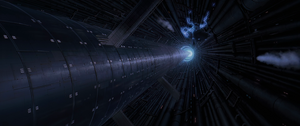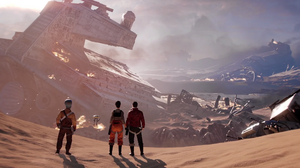| | |
- "In the month since the Battle of Jakku, the Empire has attempted no further large-scale offensives. Sources report all Imperial vessels within the Core and Inner Rim staying within the boundaries defined by the treaty. A few prominent members of the Provisional Senate have speculated that the New Republic's war with the remnants of the Empire has finally come to an end and that a final surrender may be imminent. However, in her address today, the chancellor warned that all planets should remain on high alert, and the New Republic Starfleet should be kept on a war footing for the foreseeable future."
- ―A news holo a month following the Battle of Jakku
The Galactic Concordance was a historic peace treaty that marked the end of the Galactic Civil War, a conflict between the Galactic Empire and the New Republic. The treaty was signed by former Imperial Grand Vizier Mas Amedda and New Republic Chancellor Mon Mothma on the Core world of Chandrila following the Empire's Imperial Instruments of Surrender after its defeat on Jakku, approximately five years after the Battle of Yavin and a year after Emperor Sheev Palpatine's death.
Thirty years after the Battle of Endor, the First Order emerged from hiding in the Unknown Regions and became locked in a cold war with the New Republic. The First Order in defiance, violated the treaty agreed by the Empire and began rearming itself.
Terms
The Galactic Concordance officially ended hostilities between the New Republic and Galactic Empire, and stipulated that the Empire remain within predetermined boundaries in the Core and Inner Rim and cease hostilities following its surrender. It also called for the end of the recruitment and mobilization of stormtrooper forces, the abandonment of the numerous Imperial Academies scattered across the galaxy, and the ultimate end to the Galactic Civil War. It also called for the Empire to give up its claim on the Core World of Coruscant to the New Republic, along with abandoning the practice of torture.[3]
History
Rise and fall of the Galactic Empire

The Galactic Empire was founded by Darth Sidious, Emperor and Dark Lord of the Sith.
With the dissolution of the Galactic Republic in 19 BBY, Supreme Chancellor Sheev Palpatine issued the proclamation of the New Order, effectively wiping away the thousand-year-old Republic in an instant and replacing it with his own Galactic Empire, placing himself as its first Emperor. Having eliminated the Republic and the Jedi Order through betrayal from within the Grand Army of the Republic, Palpatine would oversee the ruthless expansion of his Empire and the genocidal actions of his regime, ultimately hoping to control the galaxy and supplant all galactic authority with his new restored Sith Empire.[6]
Eventually, a loose coalition of rebel cells would come into existence to question his rule, while the eventual Alliance to Restore the Republic would be formed shortly before the destruction of the Empire's First Death Star. With the growing resistance movement threatening to end his reign, the Emperor embarked on a massive military effort to crush the Rebellion and its leaders, branding them terrorists and traitors to his rule. The following five years of galactic conflict known as the Galactic Civil War would see numerous attempts to finally crush the Rebellion, with most ending in failure.[7] Following Operation Ringbreaker and Yellow Moon, the Alliance would launch a successful attack against the Emperor's second Death Star under construction over the Sanctuary Moon of Endor.[8][9]

The Emperor's death precipitated a political crisis in the Empire.
Following the destruction of the Empire's new battle station, along with the death of Emperor Palpatine and his right-hand man Darth Vader, the Rebel Alliance's successor government the New Republic would slowly push its way towards the Empire's capital of Coruscant in an effort to restore freedom to the galaxy.[10] The New Republic re-established the Galactic Senate on Chandrila. Over the next year, the New Republic would win a string of victories against the Empire, and liberated numerous worlds including Akiva, Sevarcos,[11] Kuat, Arkanis, and Kashyyyk from Imperial rule.[12]
The Empire splintered into several Imperial remnants including Grand Vizier Mas Amedda's ailing regime on Coruscant, Lozen Tolruck's Kashyyyk remnant,[12] Governor Ubrik Adelhard's Imperial remnant,[13] Governor Ecressys' Imperial remnant,[5] and Grand General Kenner Loring's faction.[12] The largest and most powerful of these remnants were Grand Admiral Rae Sloane's forces in the Vulpinus Nebula. While the public face of the Empire, Sloane was a puppet of Fleet Admiral Gallius Rax, who secretly controlled other Imperial forces in the Almagest, the Recluse's Nebula, the Ro-Loo Triangle, and the Inamorata.[12] Rax was also privy to the Emperor's secret Contingency, a plan to destroy the Empire should it outlive Emperor Palpatine.[2]

The Battle of Jakku was the last major battle in the Galactic Civil War.
After sending Sloane to negotiate faux peace talks with the New Republic, Rax engineered the Liberation Day attack on Chandrila. In Sloane's absence, Rax seized power as Counselor to the Empire and ordered the Imperial remnant fleets to assemble at Jakku.[12] While Rax publicly claimed that he wanted to prepare the Empire for a final showdown with the New Republic, his plan was to destroy both the Imperial and New Republic forces by detonating the planet's core. Several months later, Norra Wexley and her team discovered the Imperial forces on Jakku.[2]
Following some deadlock in the Galactic Senate, Chancellor Mothma managed to secure sufficient votes to send New Republic forces to Jakku. After a fierce space and land battle, New Republic forces led by Admiral Ackbar managed to break the Imperial defenses by downing Rax's flagship, the Super Star Destroyer Ravager. Norra and Sloane then joined forces to stop Rax from detonating Jakku's core. After Rax's death, Sloane fled into the Unknown Regions with Commandant Brendol Hux, his son Armitage, and a contingent of Rax's child soldiers aboard a replica of the Emperor's yacht Imperialis.[2]
Signing the Concordance

The Galactic Concordance marked the end of the civil war, recognizing the New Republic's victory over the Empire.
Amidst the fighting on Jakku, Grand Vizier Mas Amedda escaped from house arrest on Coruscant with the help of the Anklebiter Brigade, a group of child resistance fighters based on Coruscant. He initiated contact with Chancellor Mon Mothma and sued for peace. The two leaders met on the crystal cliffs north of Chandrila's capital Hanna City. For the signing of the Imperial Instruments of Surrender, Mothma was accompanied by Princess Leia Organa, and her two new advisers: the former Imperial Loyalty officer Sinjir Rath Velus and Hosnian Prime's Sondiv Sella. On the day that the Instruments of Surrender were signed, Leia went into labor and gave birth to her son, Ben Solo.[2]
Under the terms of the Instruments of Surrender, the Empire was ordered to cease fighting and called for the final disbandment of Palpatine era government, faciliting Amedda stepping down as head of the Empire. Mothma also signed a further declaration classifying all surviving Imperial officers who did not adhere to the terms of surrender as war criminals. However, non-combatant functionaries including Amedda were granted conditional pardons.[2] Under the terms of surrender, the Imperial remnant was also compelled to accede to the demands of the Galactic Concordance, including a ban on the recruitment and mobilization of stormtroopers, the abandonment of the galactic-wide network of Imperial Academies, the surrender of Coruscant to the New Republic,[3] and the confinement of the remaining Imperial Navy to predetermined boundaries in the Core and Inner Rim.[1]
The terms of the Galactic Concordance forbade the training of Imperial stormtroopers.
Despite the Imperial surrender, Imperial holdouts on Jakku and elsewhere continued resisting the New Republic for several months. New Republic forces eventually overcame the remaining Imperial forces on Jakku.[2] As a result, the New Republic Defense Fleet remained on war footing in the months after the Battle of Jakku.[1] Some Imperial warships also fled to the Unknown Regions.[3]
Some remaining Imperials refused to adhere to the terms of surrender as was done in the Core Worlds. These Imperial hardliners organized themselves into a separate remnant. While the conflict was never officially reignited, a cold war broke out between those factions. Later, these holdouts would to relocate to the Unknown Regions, including Grand Moff Randd's Queluhan Nebula remnant.[3]
Rise of the First Order
- "You will read intelligence reports from Pheryon, Kaddak, and Sheh Soahi and captured surveys from the star systems of the Unknown Regions, where the Empire has hidden shipyards, armories, research-and-development labs, and academies. All of these facilities are now working day and night on a massive military buildup—one far larger than the First Order could possibly need to defend its member worlds."
- ―A part of an address to the Galactic Senate about the First Order in Leia Organa's Grace Report
The New Republic Defense Fleet was considerably reduced after the signing of the Galactic Concordance.
The treaty's advent led to a push for peace and demilitarization by the Republic, which feared repeating the mistakes of the former Galactic Republic during the Clone Wars. One of the first acts of the restored Galactic Senate was to pass the Military Disarmament Act, which reduced the New Republic Defense Fleet and armed forces to a token force compared to what the galaxy had as part of the Galactic Empire. Despite this, the Republic would still maintain the largest fleet in the galaxy; nevertheless, it was a fraction of the size of the Republic Navy at the height of the Clone Wars.[3]
With the Senate now firmly believing the Imperial remnant posed little threat, it turned its attention to reshaping galactic politics, most notably deciding not to place its new capital on Coruscant but rather have its capital shift across member worlds by a process of election. This moving rotation convinced many of the Republic's intentions of not becoming another Galactic Empire, and increased its membership to include many dissatisfied systems that had withdrawn from the Old Republic and formed the Confederacy of Independent Systems during the Secessionist Movement.[3]

The First Order disregarded the Galactic Concordance, allowing a new generation of stormtroopers to rise.
With many senators believing that the new peace was permanent, Chancellor Lanever Villecham and the rest of the Galactic Senate focused primarily on forging improved trade relations with the neutral systems of the Trans-Hydian Borderlands, despite the growing threat of the First Order, a successor state to the Old Empire founded by those groups of remnants who disagreed with the Concordance and relocated to space beyond the Outer Rim during the cold war.
While the Chancellor believed this new galactic government posed no threat as long as it adhered to the dictates of the Galactic Concordance as its counterpart in the Core, the First Order had in reality been skirting the stipulations of the treaty. The First Order was utilizing new Resurgent-class Star Destroyer, which were in themselves a clear violation of New Republic-Empire treaties governing capital ships, along with blatantly ignoring New Republic bans on the Order's purchase of weaponry. In a further attempt to undermine the legitimacy of the Galactic Concordance, the First Order began the massive mobilization of stormtrooper forces and expansion of its Army and Navy, along with training its new personnel on ship-based Academies, causing many First Order personnel to view these new vessels as their homes. The First Order also developed a new generation of IT-000 interrogator droids, thus violating New Republic laws banning torture.[3]
The First Order destroyed the New Republic approximately three decades after the Galactic Concordance was signed.
Despite this, many in the Senate believed the rumored reports of growing First Order strength to be needless warmongering and alarmist speech. Individuals such as Leia Organa voiced some of the strongest protest over the First Order's mobilization for war, but corruption and ignorance branded her for fear mongering, along with tarnishing her image and reducing her reputation. Believing that the Republic was not doing enough to secure the safety of its citizens, General Leia Organa led her private military force known as the Resistance—which was funded from like-minded senators who shared her fears over the First Order—in an attempt to keep the Order in check. Despite not being sanctioned by the New Republic, the Resistance was unofficially supported by the Senate, which was hoping to avoid a conflict against the Imperial successors.[3][14]
Behind the scenes
The Galactic Concordance was introduced in the 2015 reference book Star Wars: The Force Awakens: The Visual Dictionary, written by Lucasfilm Story Group member Pablo Hidalgo.
The Legends version of the end to the Galactic Civil War was the Pellaeon–Gavrisom Treaty, which was signed nineteen years after the Battle of Yavin between the New Republic and the Imperial Remnant, none of which are part of the newer canon continuity. In Legends, the Remnant and Republic never reignited the war, but settled their differences and joined together as one.
Appearances
- Lost Stars (First mentioned) (Indirect mention only)
- Lost Stars webcomic (Indirect mention only)
- Aftermath: Empire's End (First appearance)
- Before the Awakening (Mentioned only)
- Star Wars: The Force Awakens Beginner Game
- The Last Jedi: Cobalt Squadron (Indirect mention only)
- Star Wars: The Last Jedi: Expanded Edition (Indirect mention only)
Sources
- Star Wars: The Force Awakens: The Visual Dictionary (First identified as Galactic Concordance)
- Star Wars: Complete Locations
- Star Wars Propaganda: A History of Persuasive Art in the Galaxy
- Entertainment Weekly's Ultimate Guide to Rogue One
- Star Wars: The Visual Encyclopedia
- Star Wars: On the Front Lines
- Star Wars: The Last Jedi: The Visual Dictionary
- The Last Jedi: Bomber Command
- Star Wars Encyclopedia of Starfighters and Other Vehicles (Indirect mention only)
- The Last Jedi: Rose Tico: Resistance Fighter (Indirect mention only)
- Star Wars: The Complete Visual Dictionary, New Edition
- TIE Fighter Owners' Workshop Manual
 Admiral Ackbar in the Databank (backup link)
Admiral Ackbar in the Databank (backup link) The New Republic in the Databank (backup link)
The New Republic in the Databank (backup link)
Notes and references
- ↑ 1.0 1.1 1.2 1.3 1.4 Lost Stars
- ↑ 2.0 2.1 2.2 2.3 2.4 2.5 2.6 2.7 Aftermath: Empire's End
- ↑ 3.00 3.01 3.02 3.03 3.04 3.05 3.06 3.07 3.08 3.09 3.10 3.11 3.12 3.13 3.14 3.15 3.16 3.17 3.18 3.19 Star Wars: The Force Awakens: The Visual Dictionary
- ↑ 4.0 4.1 Star Wars: Galactic Atlas
- ↑ 5.0 5.1 Star Wars Propaganda: A History of Persuasive Art in the Galaxy
- ↑ Star Wars: Episode III Revenge of the Sith
- ↑ Star Wars: Episode IV A New Hope
- ↑ Battlefront: Twilight Company
- ↑ Moving Target: A Princess Leia Adventure
- ↑ Star Wars: Episode VI Return of the Jedi
- ↑ Aftermath
- ↑ 12.0 12.1 12.2 12.3 12.4 Aftermath: Life Debt
- ↑ Star Wars: Uprising
- ↑ Star Wars: Episode VII The Force Awakens
Template:Canon Galactic Civil War

